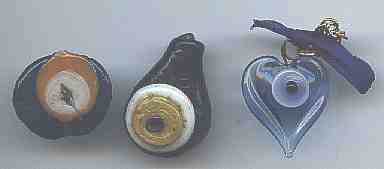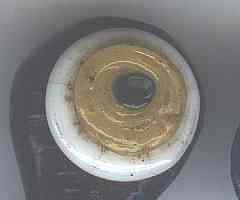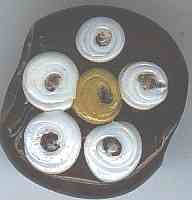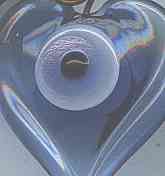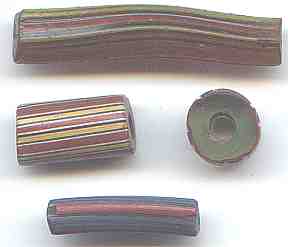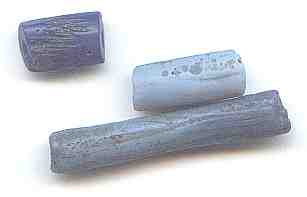The Bead SiteHome> Bead Chat Line > Picture Post
|
Bead Chat Line Picture Post
How to post a picture: Email me here and describe the picture. You must include the file size and the format (.jpg only accepted). Follow the instructions I give you in my return email.
|
|
|
Eric writes [my comments in square brackets]
Hello, we recently acquired an intriguing agate bead necklace in Bamako. It consists of very flat losange shaped agate beads. The individual beads are up to 6.5 cm long and 5.5 cm wide and are less than a cm thick. They have nicely rounded edges and are perforated along the greatest length.
The perforations seem hand made considering their conical form. The agate is often quite beautiful with delicate colour zonations and has obviously been well chosen. I have found no reference to this kind of bead being made in India (lots of those on the market). Somebody told me they could be as old as 3000 years. Any clues ????? [Agree they are not Indian. They could be much younger.]
There are obvious recent imitations (sic) in babaghoria agate or some sort of carnelian. These are much smaller (biggest one I have is only 3 cm long), have squared edges and are far from being as well finished or elegant.
[These sound like Indian diamond tabulars, dating from Roman through early modern times. They were not necessarily imitations of these agate beads.]
The holes in the beads are maximum 4 to 4.5 mm wide for the largest beads and about 3 mm for the smaller beads. They are definitely conical, in the center of the bead they are probably not even 1 mm wide. I believe them to be handmade. [Nearly all perforations in stone beads are hand made.]
One about 5 cm losange agate beads shows the hole coming to surface on one of the sides of the bead. I don't what happened to the poor thing but with a hand lens I can not see distinctive markings on the inside of the hole.
[The conical holes indicate that the bead was not drilled with a double-tipped diamond bit, which has been in use in India for 2200 years or more. It would have been drilled with copper or wood (both using abrasive) or possibly a tougher stone, such as jasper.
These would not leave fine, concentric lines.]
__________________________________________________
Small Bead Businesses | Beading & Beadwork | Ancient Beads | Trade Beads
Beadmaking & Materials | Bead Uses | Researching Beads | Beads and People
Center for Bead Research | Book Store | Free Store | Bead Bazaar
Shopping Mall | The Bead Auction | Galleries | People | Events
The Bead Site Home | Chat Line | Contact Us | Site Search Engine | FAQ
